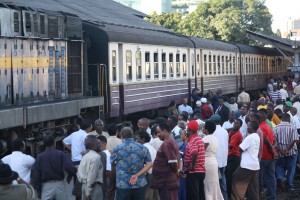
Train services from Dar-es-Salaam to Kigoma resumed in June, although limited to only one serice per week. Photo Jackson Odoyo
The problems facing Tanzania Railways Ltd (TRL) have not been resolved (they have been described in several issues of TA) but a number of new developments have been reported during recent months.
In May it was revealed that the India-based firm RITES was demanding $86 million (about Shs 125billion) as the cost of ending the 25-year deal it had signed with Tanzania three years earlier. However, the Guardian on Sunday claimed that the company hadn’t invested any money in the railways during all this time. The paper alleged that RITES had expected to use the TRL’s shares and assets it acquired in order to borrow $400 million from the International Finance Corporation/World Bank. As the quality of service on the main lines declined, the paper said, the government eventually agreed to buy back the 51% of shares RITES owns. Then, alarmed by the financial report presented by RITES, the government’s negotiation team was said to have asked for an independent auditor to verify the books of accounts, before any compensation deal could be reached. RITES apparently did not agree to this.
On June 8 the Daily News reported that the government had formed an interim management team to run Tanzania Railways Limited (TRL) while the government looked for a reliable and serious investor. RITES management had agreed to hand over the assets and operations of TRL as a decision to this end had been made by shareholders on both sides of the partnership.
TAZARA
The Tanzania Zambia Railway Authority (TAZARA), a company built with $500 million Chinese aid in the 1971’s and jointly owned by Zambia and Tanzania, is also in serious operational and financial trouble due to a fall in traffic and the old age of its locomotives, which have not been well maintained. The railway line runs some 1, 870 kilometers from Dar-es-Salaam to Zambia’s Kapiri Mposhi.
New Managing Director Akashambatwa Mbikusita-Lewanika, who was appointed in 2010 has said that the management is determined on turning around the company. It had developed a 2010 action plan which indicated what should be done to bring efficiency to the company. The company was expected to spend about $520, 000 on repairing 500 defective commercial wagons this year. The company currently had 1, 853 commercial wagons, of which only 988 were running. This rehabilitation exercise would see the company increasing its volume of cargo from the current 15, 000 to at least 72, 000 tons per month. The company’s liquidity problems had resulted in it accruing a huge debt which it was currently trying to off-set.
In 2008 the two governments had signed an agreement with the Chinese which would cover the provision of equipment, materials and other technical services valued at $40million and, in 2010, the Chinese gave the company a $39 million interest-free loan to revive its operations.
The Daily News (August 8) published a highly critical article saying that TAZARA’s low cargo load represented nothing but death itself. This view was in contrast to a TV documentary shown on British TV which was surprisingly up-beat. The programme showed a very open management struggling with great determination and remarkable resourcefulness. Among the suggestions made in the Daily News was that TAZARA should open its CEO position to international competition. ‘They should just borrow a leaf from the success of Kenya Airways (KQ) which employs the service of foreign experts in some of its important departments.’ It quoted a number of companies wanting to use the line including Tanzania Breweries, Mbeya Cement, Mufindi Paper Mills, plus the Chinese company mining coal in Chunya.

Pingback: Mkataba wa RITES Consortium, unahusu vigogo CCM - Slaa